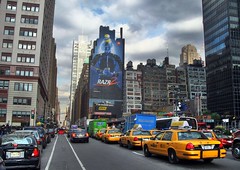The Uncanny Valley, art forgery, & love
From Errol Morris’ “Bamboozling Ourselves (Part 2)” (The New York Times: 28 May 2009):
[Errol Morris:] The Uncanny Valley is a concept developed by the Japanese robot scientist Masahiro Mori. It concerns the design of humanoid robots. Mori’s theory is relatively simple. We tend to reject robots that look too much like people. Slight discrepancies and incongruities between what we look like and what they look like disturb us. The closer a robot resembles a human, the more critical we become, the more sensitive to slight discrepancies, variations, imperfections. However, if we go far enough away from the humanoid, then we much more readily accept the robot as being like us. This accounts for the success of so many movie robots — from R2-D2 to WALL-E. They act like humans but they don’t look like humans. There is a region of acceptability — the peaks around The Uncanny Valley, the zone of acceptability that includes completely human and sort of human but not too human. The existence of The Uncanny Valley also suggests that we are programmed by natural selection to scrutinize the behavior and appearance of others. Survival no doubt depends on such an innate ability.
EDWARD DOLNICK: [The art forger Van Meegeren] wants to avoid it. So his big challenge is he wants to paint a picture that other people are going to take as Vermeer, because Vermeer is a brand name, because Vermeer is going to bring him lots of money, if he can get away with it, but he can’t paint a Vermeer. He doesn’t have that skill. So how is he going to paint a picture that doesn’t look like a Vermeer, but that people are going to say, “Oh! It’s a Vermeer?” How’s he going to pull it off? It’s a tough challenge. Now here’s the point of The Uncanny Valley: as your imitation gets closer and closer to the real thing, people think, “Good, good, good!” — but then when it’s very close, when it’s within 1 percent or something, instead of focusing on the 99 percent that is done well, they focus on the 1 percent that you’re missing, and you’re in trouble. Big trouble.
…
Van Meegeren is trapped in the valley. If he tries for the close copy, an almost exact copy, he’s going to fall short. He’s going to look silly. So what he does instead is rely on the blanks in Vermeer’s career, because hardly anything is known about him; he’s like Shakespeare in that regard. He’ll take advantage of those blanks by inventing a whole new era in Vermeer’s career. No one knows what he was up to all this time. He’ll throw in some Vermeer touches, including a signature, so that people who look at it will be led to think, “Yes, this is a Vermeer.”
…
Van Meegeren was sometimes careful, other times astonishingly reckless. He could have passed certain tests. What was peculiar, and what was quite startling to me, is that it turned out that nobody ever did any scientific test on Van Meegeren, even the stuff that was available in his day, until after he confessed. And to this day, people hardly ever test pictures, even multi-million dollar ones. And I was so surprised by that that I kept asking, over and over again: why? Why would that be? Before you buy a house, you have someone go through it for termites and the rest. How could it be that when you’re going to lay out $10 million for a painting, you don’t test it beforehand? And the answer is that you don’t test it because, at the point of being about to buy it, you’re in love! You’ve found something. It’s going to be the high mark of your collection; it’s going to be the making of you as a collector. You finally found this great thing. It’s available, and you want it. You want it to be real. You don’t want to have someone let you down by telling you that the painting isn’t what you think it is. It’s like being newly in love. Everything is candlelight and wine. Nobody hires a private detective at that point. It’s only years down the road when things have gone wrong that you say, “What was I thinking? What’s going on here?” The collector and the forger are in cahoots. The forger wants the collector to snap it up, and the collector wants it to be real. You are on the same side. You think that it would be a game of chess or something, you against him. “Has he got the paint right?” “Has he got the canvas?” You’re going to make this checkmark and that checkmark to see if the painting measures up. But instead, both sides are rooting for this thing to be real. If it is real, then you’ve got a masterpiece. If it’s not real, then today is just like yesterday. You’re back where you started, still on the prowl.
The Uncanny Valley, art forgery, & love Read More »


